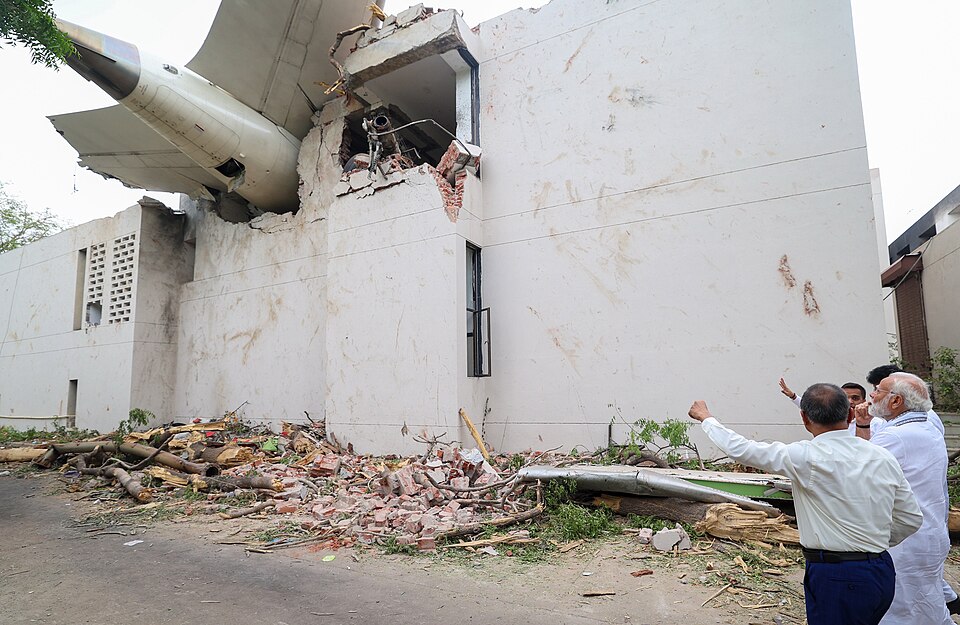On June 12, 2025, India witnessed one of its most heartbreaking aviation disasters. Air India Flight 171, a Boeing 787-8 Dreamliner (tail number VT-ANB), crashed just moments after taking off from Sardar Vallabhbhai Patel International Airport in Ahmedabad. The aircraft was on its way to London Gatwick but went down less than a minute after liftoff, claiming the lives of 241 people on board and 33 on the ground.
1. The Flight’s Departure and Crash
Flight AI171 took off at 1:38 PM IST from Runway 23 with 230 passengers and 12 crew members. Within seconds, the captain issued a mayday call, reporting serious trouble at just around 650 feet above ground. CCTV footage and eyewitness accounts confirm the plane never gained full altitude. It crashed into the BJ Medical College hostel mess building in Meghaninagar—just 2 to 3 kilometers from the airport.
The aircraft, carrying nearly 125,000 liters of fuel, exploded on impact, creating a fireball that engulfed the crash site in flames and heavy smoke. The fire spread quickly through the hostel mess building, trapping many inside.
2. Rescue Efforts and Casualties
Emergency response teams reached the site immediately. Civil defense units, fire services, and sniffer dog squads worked through thick smoke and debris. The tail section of the aircraft was found embedded in the second floor of the hostel building.
Over 270 bodies were recovered, but many were burned beyond recognition. DNA testing is being used to identify victims, and only a few bodies have been returned to their families so far. Among the 33 ground fatalities were five students from the medical college who were inside the mess at the time of the crash.
Amazingly, there was one survivor. Vishwash Kumar Ramesh, a 40-year-old British-Indian citizen sitting in Seat 11A, survived the crash. He reportedly escaped after the cabin detached and an emergency exit opened due to the impact. His survival is being described as a miracle.
3. Who Was On Board?
The passengers included:
- 169 Indian nationals
- 53 British citizens
- 7 Portuguese nationals
- 1 Canadian citizen
The tragedy also claimed the life of Vijay Rupani, former Chief Minister of Gujarat (2016–2021), who was among the passengers. Government officials are working with families to provide support, compensation, and help with the identification process.
4. The Investigation: What Went Wrong?
Both the cockpit voice recorder and flight data recorder—often called the “black boxes”—were found intact on the rooftop of the hostel. The Aircraft Accident Investigation Bureau (AAIB) of India is leading the probe, supported by international bodies like the U.S. National Transportation Safety Board (NTSB) and the Federal Aviation Administration (FAA).
Preliminary theories include:
- Configuration error: Analysts suspect the aircraft may have suffered from improper takeoff configuration—possibly due to raised flaps or incorrect gear settings.
- Thrust and lift issues: Surveillance videos show the plane struggling to climb before sharply descending.
- No engine failure: Experts have said there was no sign of engine malfunction or bird strike.
Investigators are also reviewing the actions of the pilots, runway conditions, ATC communications, and maintenance records. Full findings are expected in about three months.
5. Aviation Impact and Air India’s Position
This is the first fatal crash involving the Boeing 787 Dreamliner, a model known for its strong safety record. The crash has brought global attention to India’s rapidly growing aviation industry.
There are rising concerns about:
- Pilot fatigue and shortage
- Maintenance gaps
- Safety audits and checks
The Directorate General of Civil Aviation (DGCA) has ordered immediate inspections of all Boeing 787 aircraft in India.
Air India, now owned by the Tata Group after its privatization in 2022, is fully cooperating with the investigation. The airline had recently undergone upgrades and modernization, but this tragedy has cast a shadow over those efforts.
6. Government and Global Response
Top Indian leaders including Prime Minister Narendra Modi, Home Minister Amit Shah, and Aviation Minister Ram Mohan Naidu visited the crash site and met with families. They have pledged transparency and swift action.
Support being provided to victims’ families includes:
- Free DNA testing and body identification
- Financial compensation of ₹1 crore (about $116,000) per victim by Tata Group
- Psychological and medical support
Globally, aviation authorities and aircraft manufacturers have expressed condolences and offered assistance. Boeing is under renewed pressure to review aircraft systems and address any possible design flaws, especially in the wake of previous incidents involving the 737 MAX.
7. What Happens Next?
The coming weeks will focus on:
- Analyzing black box data
- Interviews with the sole survivor, air traffic controllers, and airline staff
- Technical examination of the aircraft’s flaps, gear, and control systems
- A review of Ahmedabad airport’s safety protocols
Experts will release a full report with findings and recommendations to prevent such incidents in the future.
8. The Human Toll
This disaster didn’t just take lives—it tore apart families. Many passengers were traveling for Eid reunions or work-related trips. Stories are emerging of children traveling with grandparents, students heading to universities abroad, and families reuniting after years.
Hospitals in Ahmedabad are overwhelmed with grieving relatives, forensic identification processes, and post-mortem exams. The emotional toll on the community and the country is immeasurable.
Vishwash Kumar Ramesh, the lone survivor, has spoken about the surreal moment he realized he was alive: “I opened my seatbelt… everything was broken. I just walked out. I don’t know how.”
Final Thoughts
The crash of Air India Flight 171 is not just India’s worst air disaster in decades—it is a global aviation tragedy. It exposed serious questions about airline safety, technical protocols, and emergency readiness. While investigations will eventually provide answers, nothing can undo the loss suffered by the families of over 270 innocent lives.
This is a moment of mourning, reflection, and resolve. It’s also a moment for the aviation world to pause and learn—so that the skies remain safer for everyone, everywhere.

